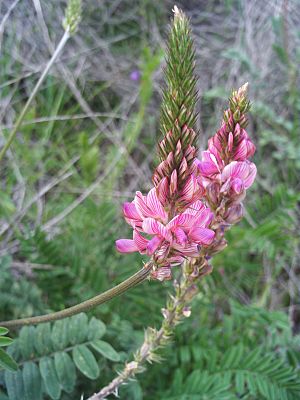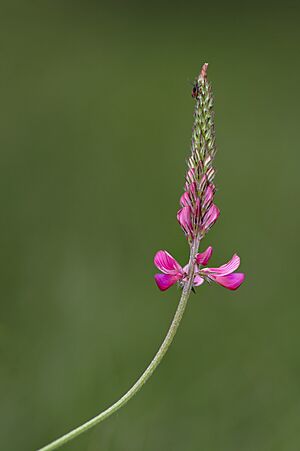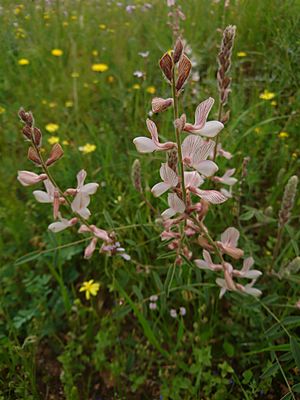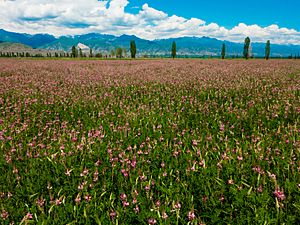Common sainfoin facts for kids
Quick facts for kids Common sainfoin |
|
|---|---|
 |
|
| Scientific classification | |
| Synonyms | |
|
List
|
Onobrychis viciifolia, also known as O. sativa or common sainfoin (pronounced ['sænfɔɪn]), is a special plant. It belongs to the legume family, like peas or beans. For a long time, it was a very important plant for feeding farm animals in many parts of the world.
However, in the 1950s, during a time called the Green Revolution (when new ways of farming made crops grow much bigger), other plants like alfalfa and clover became more popular. They produced more food for animals.
Recently, common sainfoin has become important again. Scientists found that it has natural properties that help control tiny worms, called nematodes, that can live in the guts of animals like sheep and goats. This means it can be a natural way to keep animals healthy without always needing medicines.
Contents
What is Common Sainfoin?
Common sainfoin is part of a group of plants called Onobrychis, which has 54 different types. Out of all these, O. viciifolia is the most useful for farming.
Compared to other plants used for animal feed, common sainfoin doesn't grow as fast or as big. It also doesn't compete well with weeds. This means farmers need to take extra care of it.
Helping the Soil and Nature
One amazing thing about common sainfoin is how it helps the soil. Like many legumes, it can take nitrogen from the air and turn it into a form that plants can use. This process is called symbiotic nitrogen fixation. It's not as picky as other legumes about the tiny helpers (called rhizobia) that live in its roots and do this job.
Common sainfoin also helps nature in another way. Its flowers are open and easy for insects to pollinate, especially bees. This makes it a great plant for helping to increase the number of different insects and plants in farm areas, which is good for biodiversity.
Special Plant Power
The leaves of common sainfoin have high levels of special substances called condensed tannins. These tannins are what give the plant its unique benefits. They can be five times higher in sainfoin than in plants like clover or alfalfa.
How Sainfoin Helps Animals
Common sainfoin is very good for animals, especially sheep and goats. When these animals eat sainfoin, it helps them fight off those tiny worms (nematodes) that can make them sick.
Fighting Worms Naturally
Because of the high amount of condensed tannins, common sainfoin can reduce the number of worm eggs in an animal's digestive system. This means fewer worms overall. For farmers who raise goats and sheep, feeding them common sainfoin can be a natural way to keep their animals healthy, either instead of or along with regular medicines.
Healthy Animals, Good Food
Besides fighting worms, a diet with common sainfoin can also help young sheep and goats gain weight faster. It doesn't negatively affect how much milk dairy animals produce or the quality of their milk. In fact, many studies show that animals often like eating sainfoin just as much, or even more, than alfalfa or clover.
Growing Common Sainfoin
To get the most benefits from common sainfoin, like high levels of tannins, it's best to plant it by itself. Since it doesn't compete well with weeds, farmers need to keep weeds away, especially in the first year.
Common sainfoin usually doesn't need a lot of extra plant food (fertilizer). However, adding some natural fertilizers like slurry (animal waste) or phosphate can help it grow better when it's young. Pests and diseases are rarely a big problem for this plant.
Where Sainfoin Grows Best
Common sainfoin can handle cold weather and dry conditions better than many other plants used for animal feed. But it doesn't like too much water. So, it's not a good idea to plant it in wet, clay-heavy soils that don't drain well. It also doesn't like very acidic soils.
Planting and Harvesting
Planting common sainfoin is similar to planting grains. Farmers use the same machines. About 800 seeds should be planted in each square meter of soil that is free of weeds. This can be done from spring to late summer.
In the first year, common sainfoin can be cut twice. After that, it can be cut up to four times during the growing season. It's important to cut it carefully so that not too much of the plant is lost. Once cut, common sainfoin can be stored as hay (dried grass), pellets, or silage (fermented feed) to be fed to animals later.
See also
 In Spanish: Esparceta para niños
In Spanish: Esparceta para niños




